
Big Plans in Store for the Transformation of Don Mills & Eglinton
Big Plans in Store for the Transformation of Don Mills & Eglinton
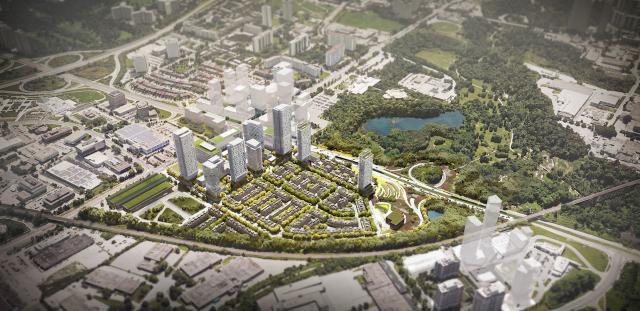
Rendering of Wynford Green looking southeast, image courtesy of Diamond Corp, Lifetime, and Context.
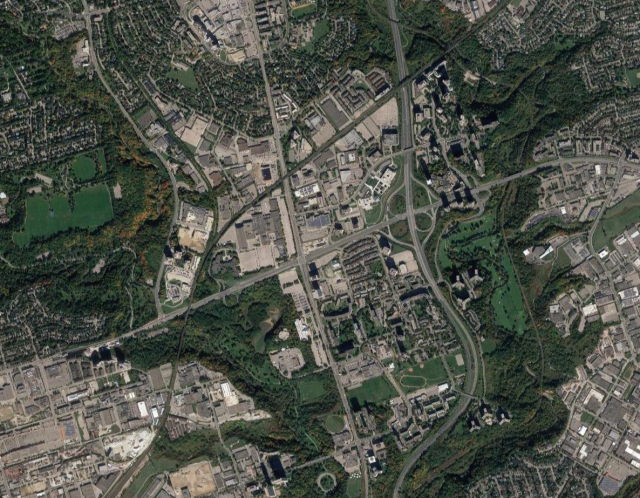
Map of the Don Mills-Eglinton area, image via Google Maps.We got an in-depth look at both ongoing projects when they were jointly presented to the Design Review Panel (DRP) in March, gaining some valuable feedback from the experts. We will begin with an overview of the City’s planning study, before diving into the Wynford Green proposal and then ending off with the comments and suggestions of the DRP.
The Big Picture: Don Mills Crossing Planning Study
The City first identified Don Mills-Eglinton as an intensification node back in 2014 when Council directed a Secondary Plan be carried out, but it wasn’t until 2016 when the Celestica site was designated a Regeneration Area that the planning study got underway. Given its proximity to three new LRT stops, with the Science Centre Station slated for the corner of Don Mills and Eglinton, the underutilized lands around the intersection are regarded as a prime location for future growth. It should also be noted that Science Centre Station will be located underground, partially to facilitate an easy connection to a future northward extension of the planned Relief Line.
The Study is centred on the four corners of the intersection, identified as the core study area, but also considers larger areas of influence. These include, in order of size, a municipal servicing area, a community services and facility area, and a transportation area, which stretches all the way from Lawrence Avenue down to the west end of Overlea Boulevard.
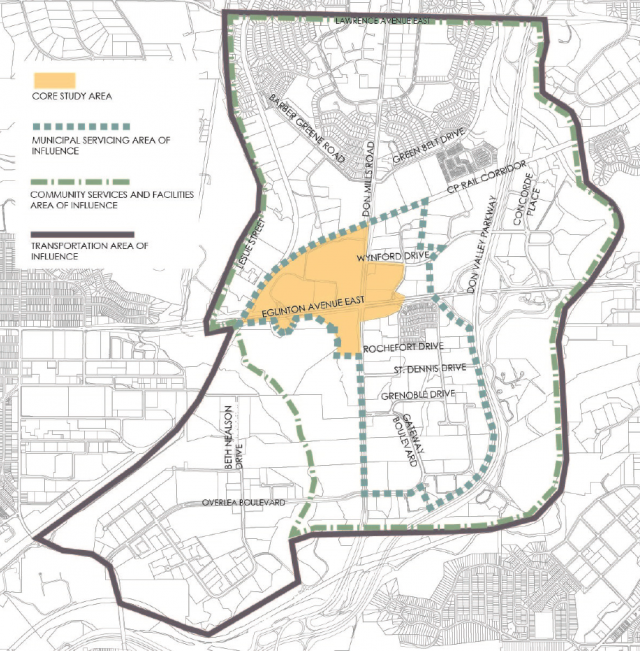
Map showing the core study area and areas of influence, image courtesy of the City of Toronto.
First developed in the post-war era, the region is designed chiefly around the private automobile, with wide expansive roads, large turning radii, and large city blocks. Having been planned primarily for industrial and employment uses, the immediate area never cultivated a human-scale street life, making movement difficult and at times hostile for pedestrians and cyclists. However, the study has revealed that a surprising number of pedestrians, cyclists, and transit users pass through the intersection each day—accounting for roughly 40% of all trips through the crossing—but roughly 75% of all local trips to and from the transportation area of influence are carried out in private automobiles. In addition, the vast majority of cars moving through the Don Mills-Eglinton intersection are simply passing through the area to get to other destinations.
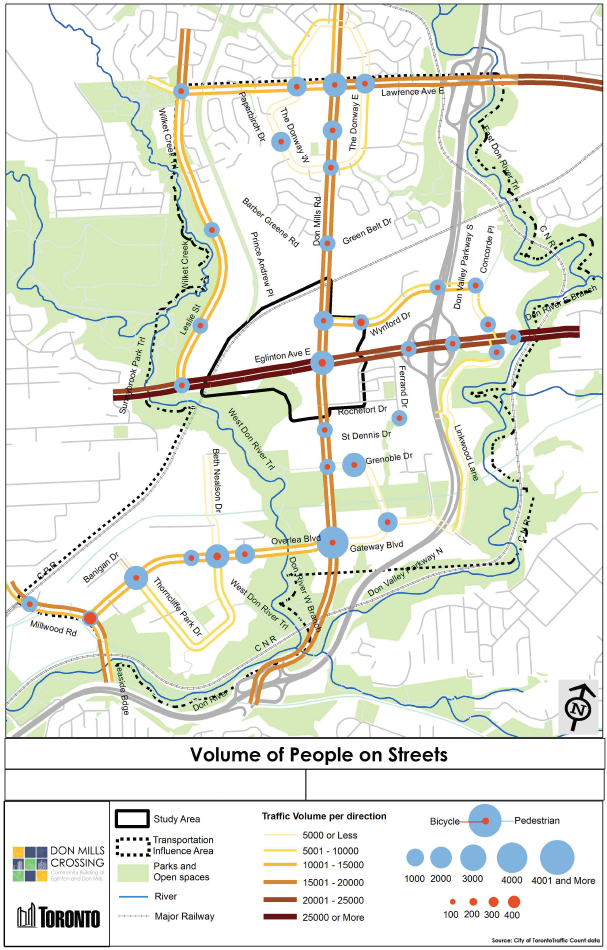
Map showing traffic patterns, image courtesy of the City of Toronto.
The study also identified a diverse range of built form throughout. The sprawling Celestica site on the northwest corner and the employment region on the northeast corner represent a low-density low-rise urban fabric with a high concentration of underused or undeveloped land. The southwest corner of the intersection is institutional lands, while the southeast corner is a mix of office towers and low-rise residential. Further out, high-density high-rise residential neighbourhoods are located to the southeast at Flemingdon Park, and across the Don to the east with the Wynford cluster. This amounts to a below-average population within walking distance to the LRT line, and a severe lack of connectivity between the different zones in the area.
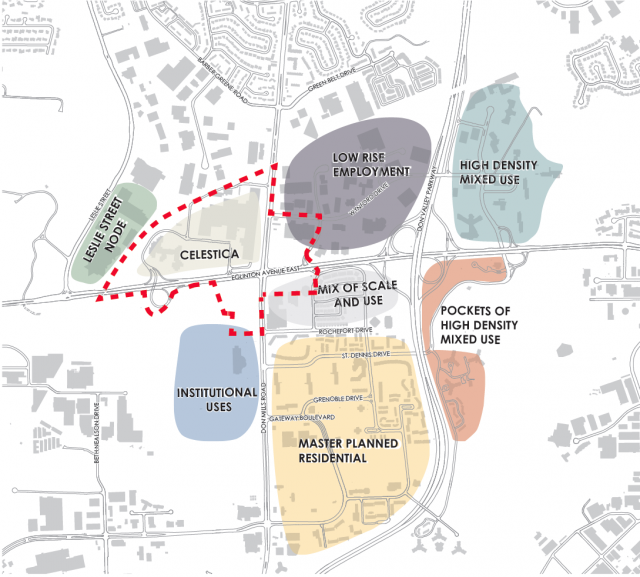
Map showing built form in the study area, image courtesy of the City of Toronto.
City Planning outlined a preliminary direction for the Secondary Plan, highlighting a few key policies that would radically transform the region. An emphasis on a diversity of uses and built forms would introduce higher density and fine-grained development to the area, encouraging a more walkable neighbourhood and placing higher concentration of employment and residences near the LRT stops. The focus of mobility would be on transit, cycling, and pedestrians, increasing connectivity to existing and future transit modes, while minimizing car use and emphasizing complete street design throughout. Greater access to green space, particularly the ravines, is stressed, while more community facilities and services will be provided for the influx of new residents. The existing institutional and employment uses would be maintained and expanded.
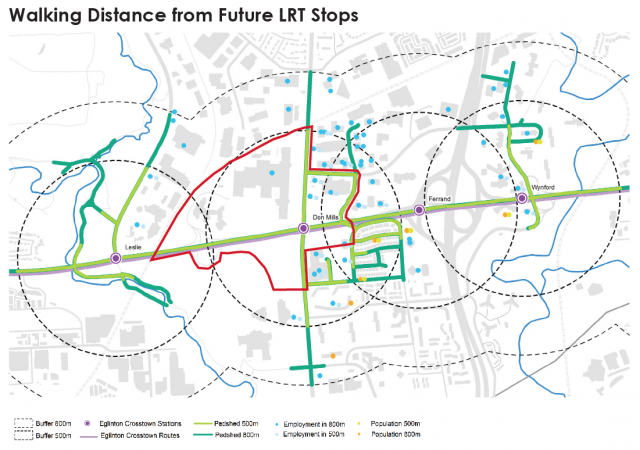
Map showing current lack of density in proximity to the LRT stops, image courtesy of the City of Toronto.
All in all, the City outlined a vision that would create a livable and walkable mixed-use community with high transit connectivity, thereby establishing Don Mills and Eglinton as a destination, rather than a thoroughfare.
The district is already beginning its transformation, with the incoming LRT line and the recent opening of the Aga Khan Museum, and may look very different a decade from now. The prospective policy direction solidifies major changes for Don Mills-Eglinton that will transform the car-centric area to a more urban, people-friendly environment. With these ideas in mind, we now examine the first major master plan for the region, Wynford Green.
The Proposal: Wynford Green Master Plan
The Wynford Green proposal builds off of the policy directions indicated by the City’s planning study and proposes a mixed-use community on the former Celestica campus. Featuring designs from TACT Architecture, Giannone Petricone Associates, and Public Work, the master plan will integrate residential uses in a variety of densities with office, retail, and public spaces, all designed around a pedestrian-and-transit-first approach. In total, the new community will house roughly 10,000 new residents and workers, with 3,887 new residential units, 120,000 sq. ft. of retail, 605,500 sq. ft. of office space, and 172,000 sq. ft. of community and cultural spaces.
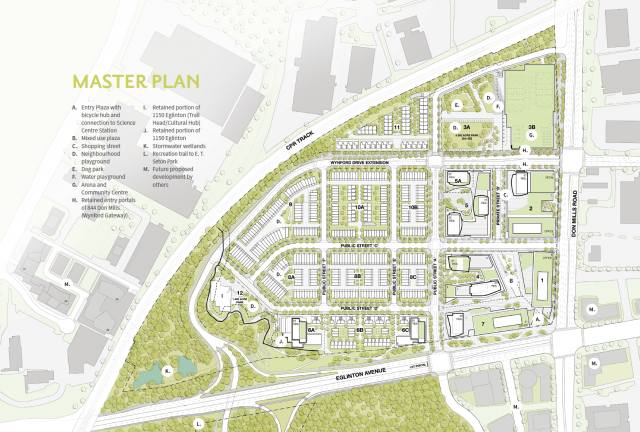
Site plan of Wynford Green, image courtesy of Diamond Corp, Lifetime Developmens, and Context Developments.
It should be noted first, though, that there are two major buildings existing on the site, both of which have been listed on the City’s heritage register. The first, at 844 Don Mills Road, is the main industrial building and former headquarters of IBM constructed in 1951 and expanded in 1954. The sprawling structure is notable for its Art Deco-inspired Modernism, with two grandiose limestone-clad entrance portals. The second building, at 1150 Eglinton Avenue East, was another office structure for IBM designed by notable Toronto architect John B. Parkin and completed in 1967, with expansions added in 1970-71. The orthogonal Modernist building follows the contours of the site, and earned itself a nomination for the Massey Medal in Architecture in 1970. A small portion of both buildings will be retained in the proposal.
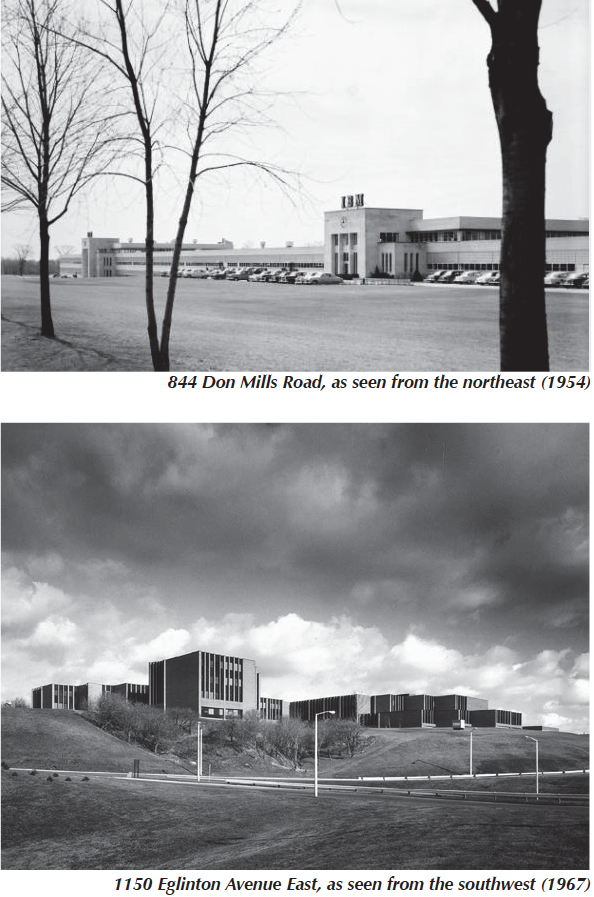
Image of the two heritage buildings, image courtesy of Diamond Corp, Lifetime Developments, and Context Developments.
The master plan features a total of nine towers, mainly clustered in the southeast corner of the Celestica site, closest to the LRT station. These range in height from 15 to 44 storeys and are all residential, with most of them having retail and/or office spaces integrated into the podiums. Office uses would front along Eglinton and Don Mills, housed in dedicated mid-rises. Celestica will maintain their presence on site, moving into a new 8-storey building designed by Sweeny &Co Architects at the corner of Don Mills and Eglinton. The remainder of development on the site will largely be stacked and full townhouses.
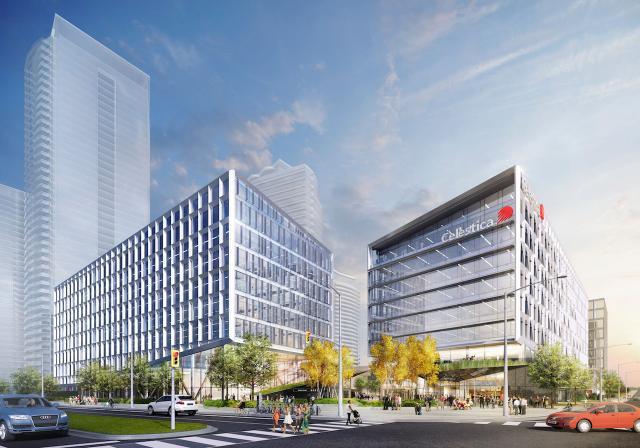
Rendering of the office buildings, image courtesy of Diamond Corp, Lifetime Developments, and Context Developments.
The public realm plays an integral role in the master plan. A north-south pedestrian spine is envisioned that runs parallel to Don Mills Road, beginning at a plaza at the corner of Don Mills and Eglinton. The ‘Main Street’, as it is referred to, will be lined with retail and will feature a second plaza at its middle, aiming to create an intimate community atmosphere separated from the busy traffic just beyond. The majority of the density is concentrated along this stretch.
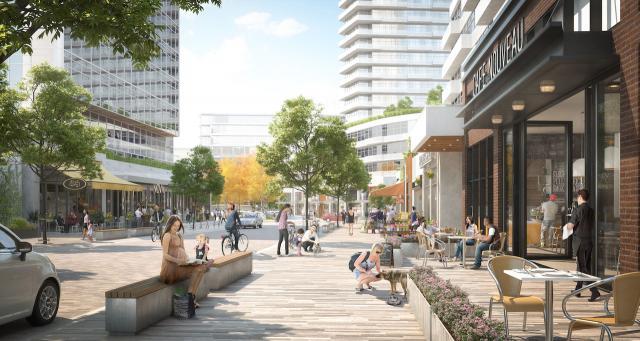
Rendering of the Main Street, image courtesy of Diamond Corp, Lifetime Developments, and Context Developments.
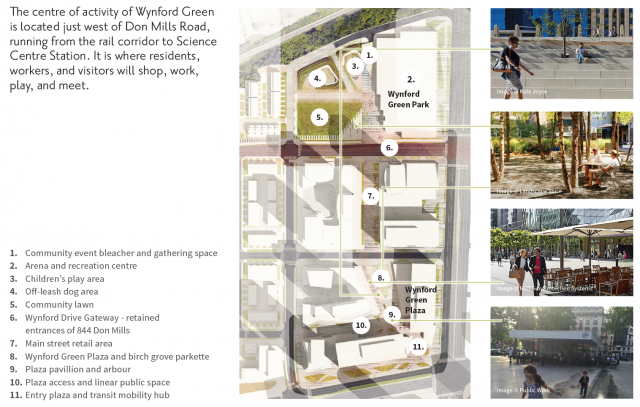
Diagram of the Main Street, image courtesy of Diamond Corp, Lifetime Developments, and Context Developments.
The Main Street will end at the new Wynford Green Park, one of two major public spaces planned for the site. Located at the northeast corner of the property, Wynford Green Park will contain a new community centre and arena designed by MacLennan Jaunkalns Miller Architects (which will replace the existing Don Mills arena located further north), and will feature flexible open green space, envisioned as a community hub and gathering place. The two entrance portals of the Celestica building will be retained and relocated to the entrance of the park, acting as a gateway alongside Wynford Drive.
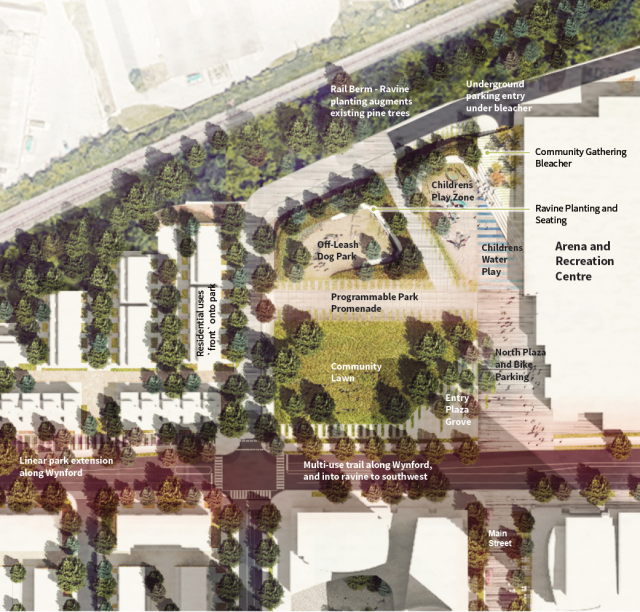
Map of Wynford Green Park, image courtesy of Diamond Corp, Lifetime Developments, and Context Developments.
The second major public space is located at the southwest corner of the property, and is dubbed Blufftop Park. The park will act as the gateway into the ravine network, with a lookout and children’s play area, as well as a retained portion of the Parkin building to be reused as a park pavilion and community hub.
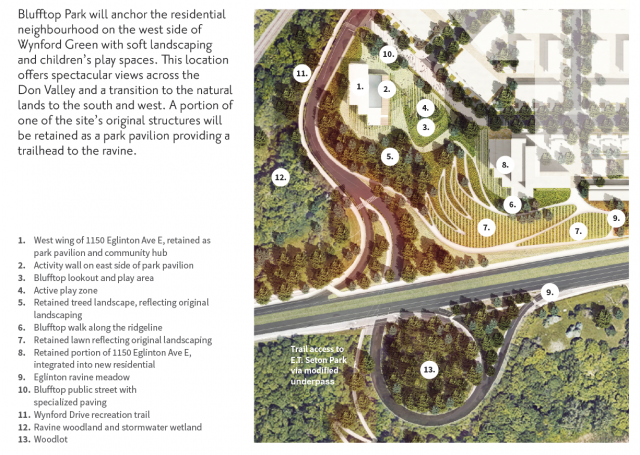
Map of Blufftop Park, image courtesy of Diamond Corp, Lifetime Developments, and Context Developments.
The connection of the site to the ravine is central to the planning of the community, with all roads and green spaces funnelling toward the natural amenity. Access into the ravine is aided by the existing private on and off-ramps to Eglinton Avenue, which already provides a passage underneath the busy road that can be continued downward into the valley for pedestrians and cyclists.
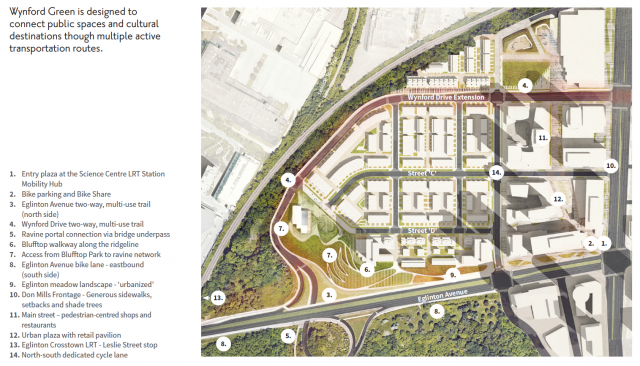
Map of showing public realm, image courtesy of Diamond Corp, Lifetime Developments, and Context Developments.
A new road network is planned for the neighbourhood that would feature an extension of Wynford Drive to connect to the private interchange with Eglinton at the southwest corner of the site. Wynford is envisioned as a tree-lined complete street, with cycling and pedestrian infrastructure leading into the ravine system.
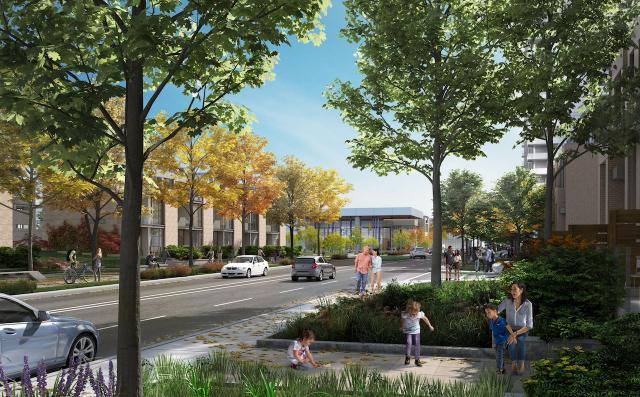
Rendering of Wynford Drive, image courtesy of Diamond Corp, Lifetime Developments, and Context Developments.
Overall, the Wynford Green proposal would transform a sprawling underused industrial site into a complete community centred around human-scale design at street level, with increased connections to the adjacent natural features, and easy access to transit.
What The Experts Had to Say
Panel members were unanimously enthusiastic about the proposal, praising the pedestrian- and community-oriented aspects of the design. They complimented the designers about the “ambitious remediation” of the “inhospitable pedestrian environments”, and applauded the connectivity of the master plan both to transit and the natural landscape. Expressing their excitement, Panelists had mostly positive things to say about the project, however, they did make a few suggestions for improvement and refinement of the design.
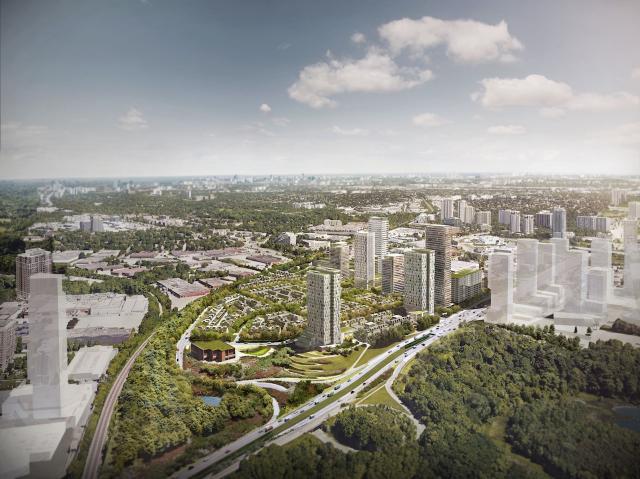
Rendering of Wynford Green looking northeast, image courtesy of Diamond Corp, Lifetime Developments, and Context Developments.
Several Panel members cautioned about the consideration of vehicular traffic, claiming that the pedestrian, transit, and cycling approach—while encouraged and recommended—would not necessarily eradicate car use in the area. The main concern was Wynford Drive, envisioned as a central parkway and complete street through the site, which Panelists pointed out could be utilized as a quicker throughway for vehicles avoiding the Don Mills-Eglinton intersection. The design of the street would be imperative to reducing the impact of potential traffic, with one Panel member claiming that the success of the project depends on the treatment of Wynford.
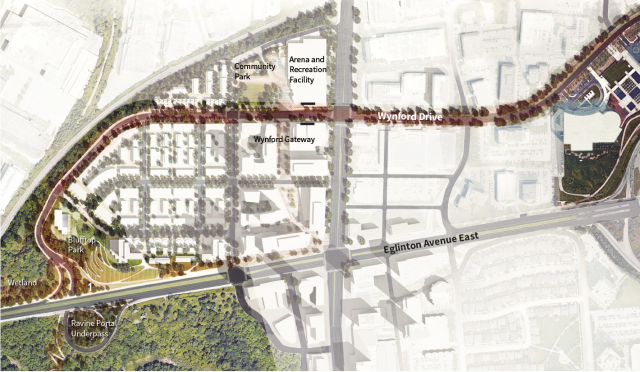
Map showing Wynford Drive, image courtesy of Diamond Corp, Lifetime Developments, and Context Developments.
Another issue that the Panelists raised was the missing middle, or rather, the lack of mid-rise residential buildings in the proposal. Designers pointed to the podiums of the towers as mid-rise, however, the Panel insisted that the inclusion of stand-alone mid-rise residential buildings would provide a further mix of unit types while providing a proper transition between the towers and townhouse components. The height of the towers could also be slightly reduced, as the lost density can be recovered through the mid-rise buildings.
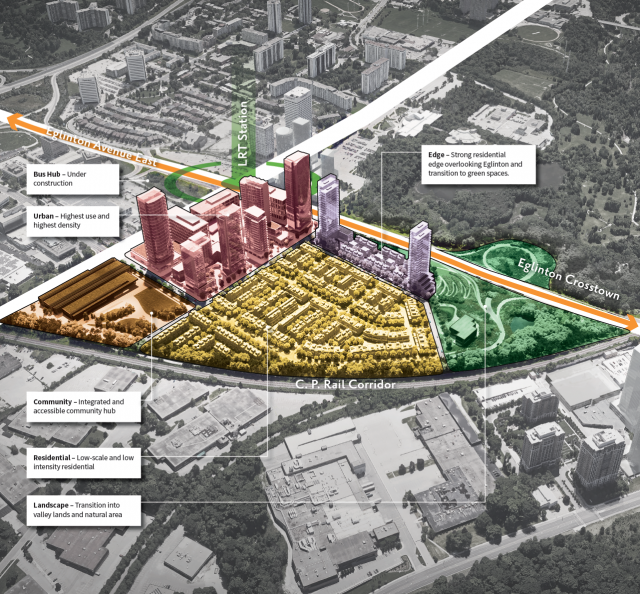
Diagram showing program in Wynford Green, image courtesy of Diamond Corp, Lifetime Developments, and Context Developments.
Finally, the issue of heritage was raised, with Panel members hoping to see more in terms of preservation of the existing structures. The Panel warned against what one member termed the “tombstone method”, where a piece of a building is kept and relocated to another portion of the site as a sort of memorial to what once stood there, rendering it more or less useless other than as a signpost. It was suggested that more consideration be done to reuse some of the buildings, which can easily be repurposed as community centres, office, or retail, rather than treating the property as an empty greenfield site. Panelists urged designers that this was an opportunity to set a precedent in the city for the adaptive reuse of heritage Modernist buildings.
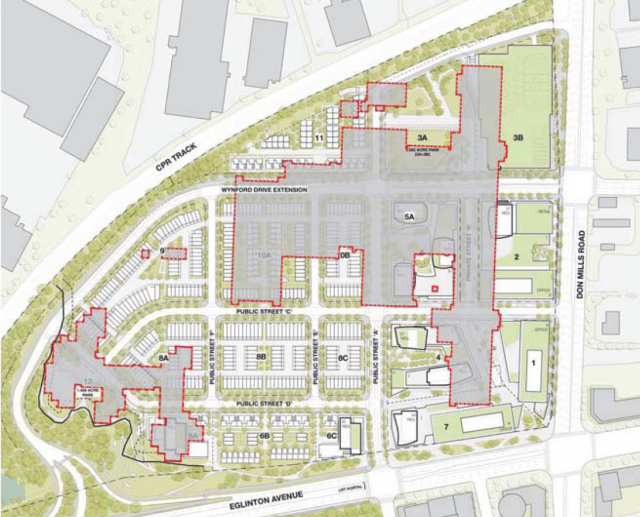
Map showing heritage buildings in relation to Wynford Green, image courtesy of Diamond Corp, Lifetime, and Context.
Overall the response was enthusiastically positive, with many Panel members impressed with the quality of the work presented. As this consultation was voluntary on the part of the developers and was a pre-application request, there was no vote held at the end of the meeting, but nonetheless, it was clear that the project garnered the support of the Panel.
We will come back with more updates about these exciting projects as they become available. In the meantime, you can find out more info by clicking on the dataBase file linked below, or you can get in on the discussion by checking out the associated Forum threads, or by leaving a comment in the space provided on this page.